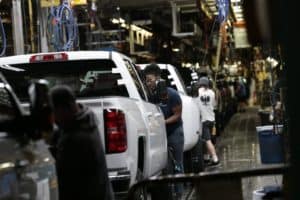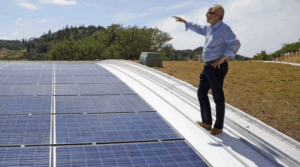
Workers inspecting vehicles at a General Motors assembly line in Flint, Mich.
Credit: Jeff Kowalsky/Bloomberg/ Getty
Breaking with some of their biggest rivals, General Motors, Fiat Chrysler and Toyota said Monday they were intervening on the side of the Trump administration in an escalating battle with California over fuel economy standards for automobiles.
Their decision pits them against leading competitors, including Honda and Ford, who this year reached a deal to follow California’s stricter rules. It represents the latest twist in one of the Trump administration’s most consequential rollbacks of regulations designed to fight climate change. It has also opened a rift among the world’s biggest automakers — the very industrial giants that the Trump administration maintains it was trying to help with regulatory relief.
The Trump administration has proposed a major weakening of federal auto emissions standards set during the Obama administration, prompting California to declare that it will go its own course and keep enforcing the earlier, stricter standards.
The automakers siding with the administration, led […]
 “Hey Google, how’s my health this morning?”
“Hey Google, how’s my health this morning?”
“One moment,” says your digital assistant.
It takes thirty seconds for the full diagnostic to run, as the system deploys dozens of sensors capturing gigabytes of data.
Smart sensors in toothbrush and toilet, wearables in bedding and clothing, implantables inside your body—a mobile health suite with a 360-degree view of your system.
“Your microbiome looks perfect,” Google tells you. “Also, blood glucose levels are good, vitamin levels fine, but an increased core temperature and IgE levels…”
“Google—in plain English?”
“You’ve got a virus.”
“A what?”
“I ran through your last 48 hours of meetings. It seems like you picked it up Monday, at Jonah’s birthday party. I’d like to run additional diagnostics. Would you mind using the….?”
As the Internet of Things catapults to new heights, Google is developing a full range of internal and external sensors, monitoring everything from blood sugar to blood chemistry. The list of once multi-million-dollar medical machines now being dematerialized, demonetized, democratized, and delocalized—that is, made into portable and even wearable sensors—could fill a textbook.
Sensor Proliferation
Sensors will not only transform healthcare and diagnostics. Any electronic […]

A controversial new study claims that ancient wetlands south of the Zambezi River were the oasis from which all modern humans emerged. Today, the region is one of the world’s largest salt flats known as the Makgadikgadi pans.
Credit: Beverly Joubert/Nat Geo
A powdery white layer blankets the desiccated landscape of Botswana’s Makgadikgadi pans, one of the world’s largest salt flats. But some 200,000 years ago, this blank canvas would have been painted in the blues and greens of a flourishing wetland. Set in the middle of a harsh desert in southern Africa, the lush landscape would have been an appealing place for early humans to call home.
Now, a controversial new study in Nature argues that this oasis, known as the Makgadikgadi–Okavango wetland, was not just any home, but the ancestral “homeland” for all modern humans today. The researchers studied mitochondrial DNA—genetic material stored in the powerhouse of our cells that is passed from mother to child—of current residents across southern Africa. Then they layered the genetic […]

Christian Oggenfuss stands near solar panels on top of the living roof at the Odette Estate winery in Napa, Calif. A new estimate from the U.S. government shows that California met about half of the state’s electricity demand for three hours on March 11, 2017–the state’s goal is for 50 percent of all electricity to come from renewable sources by 2030.
Credit: AP/Eric Risberg
While US President Donald Trump may be “the world’s most powerful climate change denier”, our latest research suggests that he took over a thriving green economy.
According to new data, by 2016 it was generating more than US$1.3 trillion in annual revenue and employed approximately 9.5m people — making it the largest green market in the world. It’s been growing rapidly too — between 2013 and 2016, both the industry’s value and employment figures grew by 20%.
For some time, economic data on the green economy in many countries has been lacking. In the US, the Bureau of Labor Statistics stopped measuring jobs in the green economy in March 2013 due […]

Chicago public school teachers and their supporters picket on Oct. 17.
Credit: Scott Olson/Getty
There’s a shortfall in education across the U.S., with more than 300,000 unfilled public teaching jobs needed to keep up with enrollment, according to an analysis from the Economic Policy Institute.
Driving the news: 25,000 Chicago Public School teachers have been on strike for more than a week, asking for capped class sizes, higher salaries and more hiring capacity for teachers’ assistants and nurses. The number of teachers picketing hit a 7-year high, according to BLS data.











